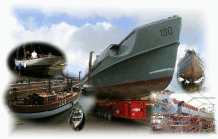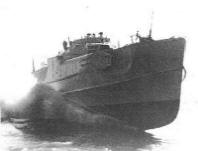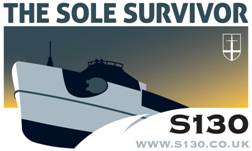


Re-Build ~ New Build ~ Repair
 |
 |
 |
| Shipwrights & Boatbuilders | ||
|
Project
Restorations Re-Build ~ New Build ~ Repair |
| Updated: 27 April 2012 | |
| S130 | |

 |
|
| WW2 German Schnellboot Restoration | |
Reconstruction - Part 5HullTimber Work |
|
|
Hull Structure |
|
|
August, September 2011 |
Support Cradling at the Stern |
|
|
|
Over time, through drying out and weakening from dismantling, the hull at the stern was beginning to sag at the turn of the bilge. Support cradling has been installed to stop any further movement. Ports have been built into the support bulkheads behind each shaft to allow the shaft logs to be extracted. |
October, December 2011 |
|
Before removing the shaft logs it would be necessary to check their position and alignment compared to that shown on the lines plan.
In order to carry out this excersise we could either use a string line or employ the use of a laser. As we would have a number of alignment tasks to accomplish, a laser was the obvious choice. Alignment lasers tend to be somewhat over complicated and expensive when our requirement called for nothing more complicated than a simulated string line. After considerable research, we decided to make our own unit consisting of a powerful, focusable laser diode in a custom mount which could be installed in one end of the stern tubes with a target in the other end. With other mounting arrangements the laser could be used on a tripod and on the boring table. |
|
Our initial measurements indicated that there was a significant difference between the port and starboard shaft lines and that the angle of all three shaft lines were running too low. This indicated that the keel line was not running true there may be some twist in the hull.
In order to find and correct the problem we would need to locate the design warterline both inside and outside the boat. For this purpose we set up our aligmrnent laser and used a horizontal/vertical laser level at a number design stations over the length and compared the waterline height measured off the lines plan with that of the boat. Once we had sufficient information, we jacked up or lowered the keel as required, while constantly checking the thwartsips level. This process was repeated a number of times until the boat was brought to within suitable tollerances. In the final analysis, we achieved a declivity of 0.018m over 34.9m and a variance (keel rabbet to waterline) of 6mm-10mm.
On checking the shaft lines we finally achieved a set of measurements in accordance with the lines plan so work on extracting the old shaft logs and making new replacements could commence. |
|
A hole with a diameter of 206mm will have to bored for a length of 4m through the shaft logs. In preparation for making and boring the replacement shaft logs, an accurately level boring table has been constructed on which the logs will be bored to accept the stern tubes. A pair of plummer block bearings are mounted at each end to support the boring bar and rails have been laid up to one end, on which a heavy duty, trolley mounted, drill will run. |
January, February 2012 |
|
The hull planking inway of the wing shaft logs was removed along with the aluminium metal work and adjacent timber ends before the logs were lowered onto a 'skateboard' fabricated from scaffold boards attached to rollers. The logs lowered onto the 'skateboard' and rolled down the ramp and out through the support bulkheads. Once out, they were turned and transferred to a trolley and stowed ready to lift patterns. |
|
With patterns and all information taken off the shaft logs, the stern tubes were carefully broken out to be transported to Wheatcroft HQ for disassembly and cleaning prior to being reinstalled in the new logs. |